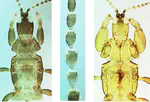Social ecology of cooperation
 Dunatothrips armatus family
Dunatothrips armatus familyTitle
Despite nearly fifty years of research and debate about theoretical conditions that might favour the evolution of sociality, we still know little about the kinds of environments that select for social behaviour in nature. One long-standing gap in our knowledge about the evolution of social behaviour is the idea that inadequate nutrition limits opportunities for individuals to breed independently, favouring social living. This knowledge gap has existed because the model systems that are most informative about evolutionary transitions to sociality (socially plastic species, i.e. which are able both to breed alone and in social groups) have proven to be intractable when it comes to manipulating nutrition. Key to testing this are species that can both be social or solitary – for example Acacia thrips (Dunatothrips spp.).
We conducted some of the first studies on the natural history of facultative sociality in Dunatothrips. We found that the nest functions to prevent the young drying out in their arid environment, and that benefits of social behaviour depend on the size of the nest.
Our pilot data show that some individuals in cooperatively founded nests are neither reproductive nor helpful - they appear ’lazy’. They may be of too poor quality either to breed or help.
